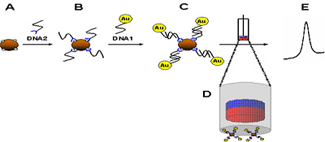New DNA system detection based on the use of nanoparticles of gold

Gold nanoparticles have unusual properties compared with other elements. We have taken advantage of this characteristic to create a new type of biological marker. The Sensors and Biosensors Group at the UAB, jointly with the Institute of Molecular Biology in Barcelona, have worked with biochemical techniques and applied the advances of nanotechnology.
Nanoscience and nanotechnology are setting a new path in the field of development of new sensors for the detection of DNA. With the aim of linking biochemical techniques with some of the advantages of nanotechnology we have developed a new system of detection which has recently been published in the journal Langmuir and which is a collaboration between the Sensors and Biosensors Group at the UAB, and the Institute of Molecular Biology in Barcelona.
The use of nanoparticles is currently proposed as a new alternative to other markers (isotopes, enzymes, fluorescent molecules) in an attempt to achieve, on the one hand a more sensitive, precise, rapid, stable and cheaper detection, and on the other hand and more importantly, the simultaneous detection of various types of DNA in the same sample.
Metal nanoparticles have unusual physical properties (structural, electronic, magnetic and optical) and (electro) chemical properties which make them perfect candidates as biological markers. Their properties depended to a great extent on their size (between 2-10 nm) and the stabilizing agent which they have on their surface and which is absolutely essential to prevent the nanoparticles from losing their nanoscopic structure and joining together and forming micro or macroscopic structures.
The new system of detection developed is based on the detection of an immobilized DNA sequence on magnetic micro particles by means of hybridisation with a complementary DNA probe marked with a gold nanoparticle which contains approximately 67 atoms (also known as Au67 Quantum Dots or Au67 QD). The connexion between Au67 QD and the DNA probe is made so that the union DNA / Au67 QD is of the order of 1:1 thus avoiding the formation of undesired networks between the magnetic micro particles and the DNA probes, and thus increasing the sensitivity of the assay.
Gold nanoparticles anchored to the magnetic micro particles by means of the hybridised DNA probes approach the surface of a magnetic sensor thanks to a small magnet on the body of the sensor. The number of nanoparticles anchored is detected by a differential pulse voltammeter and is related to the number of DNA probes present in the sample analysed.
This new system may well have an impact not only in the field of DNA analysis but also in that of nanotechnology and nanoelectronics. Recently the same group has been working on the system by developing a platform called lab-on-a-chip.
References
Article: "Magnetically trigged direct electrochemical detection of DNA hybridization using Au67 quantum dot as electrical tracer", Langmuir 21, 9625-9629 (2005)

